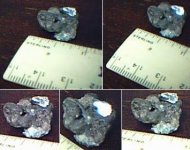1liquigirl
Sr. Member
I found this in the backyard of my 1879 Victorian home, back in August (a few pics below). I thought it was lead because it seemed heavier than a rock would be of the same size, so it sat on my entertainment center for months. Tonight I vacuumed it and a piece of it chipped off onto the floor and another piece is now missing and probably somewhere in the vacuum bag, for a total of at least three pieces. I ran my Garrett 250 ace over it again tonight and it beeps on all modes from relic, jewelry, coins, and all metal in the 1 cent and 10 cent areas, which above is the high area of gold or bronze and low area of silver. When it was one piece, it somewhat had the shape of a cross to it. The longest section being the one that is broke off closest to the ruler. The broken off sections are extremely shiny and metalic, like a piece of aluminum foil, one of them I placed on top of the largest piece for the pictures. Stupid of me to run it through the vacuum before thinking it could be something valuable. Could this be silver? Can anyone help me with ideas on how to tell without taking it to a jeweler?





 i have no idea if the tarnex will affect the nitric acid test or not. if i had to guess i would think not because if the acid is that corrosive it should easily go through the tarnex, but that is just a guess. i sure do hope it is silver! perhaps you could find a geologist to assist you, maybe at the local university? just a thought. good luck with it!
i have no idea if the tarnex will affect the nitric acid test or not. if i had to guess i would think not because if the acid is that corrosive it should easily go through the tarnex, but that is just a guess. i sure do hope it is silver! perhaps you could find a geologist to assist you, maybe at the local university? just a thought. good luck with it! 


